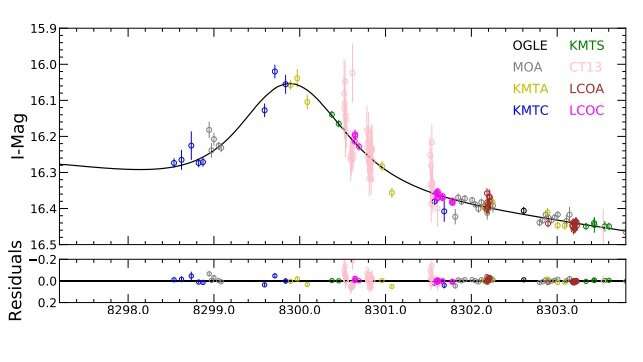October 26, 2020 report
New sub-Saturn-mass exoplanet discovered

Using the microlensing technique, an international team of astronomers has detected a new distant alien world. The newly found exoplanet, designated OGLE-2018-BLG-0799Lb, is about five times less massive than Jupiter and orbits a very low-mass dwarf. The finding is reported in a paper published October 17 on the arXiv pre-print server.
Microlensing is a useful technique for detecting alien worlds in the inner galactic disk and bulge, where it is difficult to search for planets with other methods. It facilitates the discovery of distant objects by using background stars as flashlights. If a star moves in front of another star, the light from the distant star is bent by the gravitational pull of the nearer star and the more distant star is magnified. Microlensing does not rely on the light from the host stars; thus, researchers can detect planets even when the host stars cannot be detected.
OGLE-2018-BLG-0799 was discovered in May 2018 as a microlensing event by the Optical Gravitational Lensing Experiment (OGLE) collaboration. OGLE is a Polish astronomical project based at the University of Warsaw, searching for dark matter and extrasolar planets. It uses the 1.3-meter Warsaw telescope mounted at the Las Campanas observatory in Chile.
Astronomers from the OGLE collaboration and elsewhere have conducted follow-up observations of OGLE-2018-BLG-0799 using NASA's Spitzer Space Telescope and ground-based observing facilities. Through their observations, they found a new, massive planet orbiting a dwarf star.
"In this paper, we have reported the discovery and analysis of the Spitzer microlens planet OGLE-2018-BLG-0799Lb," the astronomers wrote in the study.
The newly detected exoworld has a mass of about 0.22 Jupiter masses, what allowed the researchers to classify it as a sub-saturn-mass planet. It orbits a dwarf star with a mass of approximately 0.08 solar masses, beyond the snow line, as it separated from the host by 1.27 AU. The system is located some 14,400 light years away from the Earth, in the Milky Way's disk. OGLE-2018-BLG-0799Lb is only the second planet orbiting a very low-mass dwarf identified by Spitzer.
However, the astronomers emphasize that because of the systematics in the Spitzer photometry, it is still too soon to draw final conclusions about the properties of the system. According to the study, there is ambiguity in the parallax measurement and therefore, it is also possible that the host is a more massive star and located in the galactic bulge, farther away than estimated.
Hence, the researchers propose further studies of the system, especially adaptive optics measurements, in order to eliminate all the uncertainties.
"An adaptive optics measurement of (or constraint on) the lens flux would substantially improve the constraints on the lens and distinguish between the different parallax solutions," the authors of the paper explained.
More information: Zang et al. OGLE-2018-BLG-0799Lb: a Sub-Saturn-Mass Planet Orbiting a Very Low Mass Dwarf, arXiv:2010.08732 [astro-ph.EP] arxiv.org/abs/2010.08732
© 2020 Science X Network




















